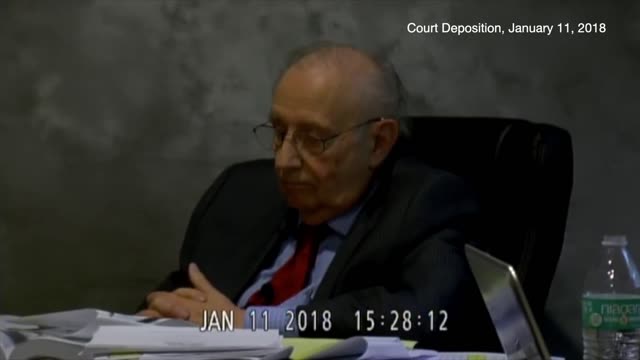Premium Only Content

Vaccinated vs Unvaccinated - Dr. Stanley Plotkin Under Oath
Dr. Stanley Plotkin is questioned under oath, about conducting a study comparing health outcomes between children receiving vaccines, and children receiving no vaccines.
https://odysee.com/@FreshlyMinted:1/comparing-vaccinated-vs-unvaccinated-dr.:e
_____________________________________
Autistic Brains Have High Aluminum Levels
http://vaccinepapers.org/high-aluminum-content-autistic-brains/
Dr. James Lyons-Weiler + Dr. Paul Thomas – Relative Incidence of Office Visits and Cumulative Rates of Billed Diagnoses Along the Axis of Vaccination
https://www.mdpi.com/1660-4601/17/22/8674
The Vaccine "Placebo" Pyramid Scheme - full lenght video - The Highwire with Del Bigtree
https://rumble.com/v1dlwtt-the-vaccine-placebo-pyramid-scheme-full-lenght-video-the-highwire-with-del-.html
Activation of the maternal immune system alters cerebellar development in the offspring
NIH-PA Author Manuscript:
http://vaccinepapers.org/wp-content/uploads/Activation-of-the-Maternal-Immune-System-Alters-Cerebellar-Development-in-the-Offspring.pdf
Autism: a novel form of mercury poisoning
PDF: http://www.worldwidehealthcenter.net/wp-content/uploads/2017/04/autism-a-novel-form-of-mercury-poisoning.pdf
__________________________________
Stanley Alan Plotkin developed vaccines in the United States during the mid to late twentieth century. Plotkin began his research career at the Wistar Institute in Philadelphia, Pennsylvania, where he studied the rubella virus. In pregnant women, the rubella virus caused congenital rubella syndrome in the fetus, which led to various malformations and birth defects. Using WI-38 cells, a line of cells that originated from tissues of aborted fetuses, Plotkin successfully created RA27/3, a weakened strain of the rubella virus, which he then used to develop a rubella vaccine. Plotkin's rubella vaccine has prevented birth defects due to congenital rubella in developing fetuses and newborns.
Plotkin was born 12 May 1932 in New York City, New York, to parents Lee and Joseph Plotkin, who had immigrated to the United States from England. Plotkin's father worked as a commercial telegrapher while his mother cared for Plotkin and his younger sister, Brenda. As an adolescent, Plotkin attended the Bronx High School of Science in New York City, New York. When Plotkin was fifteen, he read two books, Arrowsmith, a novel by Sinclair Lewis, and Microbe Hunters, a non-fiction science drama by Paul de Kruif. Both books told stories of scientists striving to discover the causes of diseases and to create vaccines against them. Plotkin later credited those books as his inspiration for studying science and medicine. After graduating from the Bronx High School of Science in 1948, Plotkin enrolled at New York University in New York City.
Plotkin graduated with his bachelor's degree from New York University in 1952 and applied to the State University of New York Medical School at the Downstate Medical Center in Brooklyn, New York. While at the Downstate Medical Center, Plotkin worked in the lab of Robert Austrian, who studied infectious diseases like pneumonia and meningitis caused by the bacteria, streptococcus pneumoniae. One classmate recalled that Plotkin had an insatiable curiosity and emphasized finding practical solutions to human health problems through rigorous experimentation, traits that Plotkin later attributed to his time spent working with Austrian. After Plotkin received his medical degree from the State University of New York Medical School in 1956, he moved to Cleveland, Ohio, where he spent a year as a pediatric intern at Cleveland Metropolitan General Hospital.
In 1957, Plotkin planned to volunteer for the US Air Force rather than be drafted for military service in the Vietnam War. According to Plotkin, he wanted to join the Air Force to learn to fly planes. But because of his medical training, Plotkin instead served for three years in the Epidemic Intelligence Service of the Centers for Disease Control in Atlanta, Georgia.
As an officer of the Epidemic Intelligence Service, Plotkin studied anthrax at the Wistar Institute. Plotkin later revealed that he requested that specific appointment because he hoped to work with the new director of the Wistar Institute, Hilary Koprowski, who had developed a preliminary oral polio vaccine. Polio was a common childhood disease that caused flu-like symptoms and sometimes affected the central nervous system, paralyzing some children. In addition to studying anthrax, Plotkin also studied the poliovirus in Koprowski's lab. He researched alternative, experimental polio vaccines and tested the new polio vaccines in the Belgian Congo, later called the Democratic Republic of the Congo.
During his initial research at the Wistar Institute, Plotkin taught at the School of Medicine at the University of Pennsylvania in Philadelphia, Pennsylvania, in 1959. To obtain credentials as a pediatrician, Plotkin worked as a resident physician at the Children's Hospital of Philadelphia in Philadelphia, Pennsylvania, in 1961. In 1962, he left Philadelphia and transferred his pediatric residency to the Hospital for Sick Children in London, England. Plotkin later stated that he enjoyed his residency there because he believed the hospital attracted some of the most difficult medical cases and some of the best pediatric consultants in England. After obtaining his pediatric credentials, Plotkin returned to Philadelphia in 1963 where he resumed teaching in pediatrics as an assistant professor at the University of Pennsylvania. He also resumed research at the Wistar Institute with institute director Koprowski.
Upon returning to the Wistar Institute in 1963, Plotkin began studying the rubella virus. The rubella virus caused a common but often mild disease that caused rashes and flu-like symptoms in those infected. However, pregnant women infected with the rubella virus could pass the virus to their fetuses, who got congenital rubella syndrome. Congenital rubella syndrome can lead to miscarriage or birth defects in the heart, brain, eyes, and ears of the fetus. In 1963, an epidemic of rubella and congenital rubella syndrome broke out in Europe. In 1964 and 1965, the epidemic spread to the United States, causing birth defects in thousands of infants. After that epidemic, many researchers, including Plotkin, accelerated the development of a vaccine for rubella. According to Plotkin, he realized the importance of preventing rubella in pregnant women to prevent congenital rubella in their fetuses and the subsequent birth defects in infants.
Throughout the 1960s, Plotkin strove to develop a vaccine for rubella at the Wistar Institute. Plotkin built upon work conducted by virologists Thomas Huckle Weller and Franklin Allen Neva as well as Paul Douglas Parkman, all of whom isolated strains of the rubella virus in 1962 in the US. In the early 1960s cell biologists Leonard Hayflick and Paul Moorhead at the Wistar Institute developed the WI-38 strain, a human cell strain created using aborted fetal tissue. WI-38 cells, named after the Wistar Institute where they were developed, were among the first non-cancerous human cells that could be maintained for long periods of time without substantial degradation, making them well-suited for laboratory research. Using WI-38 cells, Plotkin cultured a new strain of the rubella virus called RA 27/3, a weakened strain of the rubella virus, which he and his research team then used to create a rubella vaccine in 1969.
However, Plotkin was not the only one to create a rubella vaccine. In 1968 at a National Institutes of Health conference, several rubella vaccine developers debated which of four possible vaccines was the best candidate for further production. Of the proposed vaccines, only Plotkin's had used diploid human cells while other laboratories had used cells from ducks, dogs, and rabbits. Diploid human cells, like the WI-38 cells Plotkin used, have the same number of chromosome pairs as typical human body cells. Plotkin argued that diploid human cells were a better medium for growing weakened virus strains for vaccines because they better represented the human cells to be vaccinated.
Plotkin's primary opposition at the conference was Albert Sabin, who had successfully created an oral polio vaccine, similar to Koprowski's, that was widely used in the Soviet Union. Sabin objected that vaccines developed with human cells, like WI-38, contaminated vaccines with cancer causing viruses, a common theory at the time. Plotkin countered that there was not sufficient evidence to indicate such danger. He further asserted that Sabin's objections came from religious, not factual, reasons due the origins of the WI-38 cells in aborted fetal tissues. Plotkin's arguments convinced his colleagues of the benefits of his RA 27/3 rubella vaccine, eventually convincing Sabin himself. In 1969, Plotkin published his experimental results about his rubella vaccine, which became available for public use shortly thereafter.
After advocating for his rubella vaccine, Plotkin continued to balance his study of viruses and vaccines with his medical career. In the late 1960s, Plotkin collaborated with Koprowski and Tadeusz Wiktor at the Wistar Institute to create a vaccine for rabies, which became licensed for public use beginning in 1980. Plotkin also continued teaching pediatrics at the School of Medicine at the University of Pennsylvania where he remained a professor until 1991. In 1972, Plotkin became the director of the infectious disease department as well as a senior physician in pediatrics at the Children's Hospital of Philadelphia, where he remained for decades to follow. In addition to his vaccine research, Plotkin became a professor of virology at the Wistar Institute in 1974. In 1980, Plotkin married Susan, the coordinator of the pediatric AIDS Program at the Children's Hospital of Philadelphia. The couple had two children, Michael and Alec.
Throughout the 1980s, Plotkin continued to develop vaccines for infectious diseases. In the early 1980s, Plotkin created several experimental vaccines for chickenpox, caused by the varicella virus, though those vaccines never made it to public production. In 1988, Plotkin published the first edition of Vaccines, a textbook detailing the history, theory, and creation of vaccines. The US National Foundation for Infectious Diseases in Bethesda, Maryland, considered Vaccines, in its sixth edition as of 2013, to be the authoritative textbook in the field of vaccinology. Plotkin continued to seek out new vaccines, and in 1988, he published a paper for a preliminary vaccine for rotavirus, which causes severe diarrhea in infants and young children.
In 1991, a private vaccine company, Pasteur Mérieux Connaught Vaccines, offered Plotkin a position as the company's medical and science director. Plotkin accepted and relocated to Paris, France, with his family later that year. In 1997, he returned to the US as a consultant for the multinational vaccine producer, Aventis Pasteur, later called Sanofi Pasteur, headquartered in Lyon, France. In 2006, Plotkin, collaborated with vaccine researchers Fred Clark and Paul Offit in the US to create a rotavirus vaccine, which they called RotaTeq, based on research Plotkin had started nearly twenty years earlier. Also that year, at the age of 74, Plotkin learned to pilot an airplane, fulfilling his earlier ambition.
Plotkin received many awards for his work as a physician and medical researcher. For his contributions to preventative medicine, in 1987, the American College of Physicians awarded Plotkin the Bruce Medal, and in 1993, the Pan American Group for Rapid Viral Diagnosis presented him with the Clinical Virology Award. In 1998, Plotkin also received the French Legion Medal of Honor. To honor his scientific work in vaccines and combatting infectious diseases, Plotkin received the Sabin Foundation Medal in 2002, the Maxwell Finland Award in 2009, and the Hamdan Award Medical Research Excellence in 2014.
Although retired, in the second decade of the twenty-first century, Plotkin consulted on issues of vaccines and remained involved with infectious disease and vaccine research, particularly for cytomegalovirus, which can cause infants to be born with abnormalities. He was a professor emeritus at the University of Pennsylvania and at the Wistar Institute.
Sources
1940 U. S. Census, Bronx County, New York, population schedule, Assembly District 7, Bronx, New York City, enumeration district (ED) 3-1189, sheet 9B, family 181, Joseph Plotkin household. http://1940census.archives.gov/search/?search.census_year=1940&search. city=&search.county=Bronx+County&search.page=2&search.result_type= image&search.state=NY&search.street=178th+E#filename=m-t0627-02490- 00479.tif&name=3-1189&type=image&state=NY&searchby=location&searchmode =browse&year=1940&index=18&pages=22&bm_all_text=Bookmark (Accessed May 20, 2016).
Arbeter, Allan M., Stuart E. Starr, and Stanley A. Plotkin. "Varicella Vaccine Studies in Healthy Children and Adults." Pediatrics 78 (1986): 748–56.
Austrian, Robert. "Bacterial Transformation Reactions." Bacteriological Reviews 16 (1952): 31–50. http://www.ncbi.nlm.nih.gov/pmc/articles/PMC180727/pdf/bactrev00008- 0036.pdf (Accessed May 23, 2016).
Clark, H. Fred, Frances E. Horian, Louis M. Bell, Karen Modesto, Vera Goueva, and Stanley A. Plotkin. "Protective Effect of WC3 Vaccine Against Rotavirus Diarrhea in Infants During a Predominantly Serotype 1 Rotavirus Season." Journal of Infectious Diseases 158 (1988): 570–87.
Clark, H. Fred, Paul A. Offit, Stanley A. Plotkin, and Penny M. Heaton. "The New Pentavalent Rotavirus Vaccine Composed of Bovine (Strain WC3) – Human Rotavirus Reassortants." Pediatric Infectious Disease Journal 25 (2006): 577–83.
de Kruif, Paul. Microbe Hunters. San Diego: Harvest, 1926.
de Santis, Marco, Anna Franca Cavaliere, Gianluca Straface, and Alessandro Caruso. "Rubella Infection in Pregnancy." Reproductive Toxicology 21 (2006): 390–8.
"Dr. Stanley A. Plotkin to Receive the Hamdan Award for Medical Research Excellence in the Field of Vaccines." The Wistar Institute. 14 November 2014. http://wistar.org /news-and-media/press-releases/dr-stanley-plotkin- receive-the-hamdan-award-medical-research-excellenc (Accessed May 20, 2016).
Hayflick, Leonard. "The Limited in Vitro Lifetime of Human Diploid Cells." Experimental Cell Research 37 (1965): 614–36.
Hayflick, Leonard and Paul S. Moorhead. "The Serial Cultivation of Human Diploid Strains." Experimental Cell Research 25 (1961): 585–621.
Katz, Michael. "Tribute to Stanley A. Plotkin, M.D." Speech Given at the Albert B. Sabin Gold Medal Address, Baltimore, Maryland, May 7, 2002. http://www.sabin.org/sites/sabin.org/files/Plotkin_medal_speech. pdf (Accessed May 20, 2016).
Koprowski, Hilary, Thomas W. Norton, George A. Jervis, Thomas L. Nelson, David L. Chadwick, Doris J. Nelsen, and Karl F. Meyer. "Clinical Investigations on Attenuated Strains of Poliomyelitis Virus: Use as a Method of Immunization of Children with Living Virus." Journal of the American Medical Association 160 (1956): 954–66.
Lewis, Sinclair. Arrowsmith. San Diego: Harcourt Brace & Company, 1925.
National Foundation for Infectious Diseases. "Stanley A. Plotkin, MD: Recipient of the 2009 Maxwell Finland Award for Scientific Achievement." National Foundation for Infectious Diseases. http://www.nfid.org/ awards/plotkin.pdf (Accessed May 20, 2016).
Parkman, Paul D., Edward L. Buescher, and Malcom S. Artenstein. "Recovery of Rubella Virus from Army Recruits." Experimental Biology and Medicine 111 (1962): 225–30.
"Plotkin, Stanley Alan." American Men & Women of Science: A Biographical Directory of Today's Leaders in Physical, Biological, and Related Sciences. 5 (2007): 1147.
Plotkin, Stanley A. "The History of Rubella and Rubella Vaccination Leading to Elimination." Clinical Infectious Diseases 43 (2006): 164–8. http://cid.oxfordjournals.org/content/43/Supplement_3/S164.full.pdf+ html (Accessed May 20, 2016).
Plotkin, Stanley A. "Remarks upon Acceptance of the 2002 Albert B Sabin Gold Medal." Speech Given at the Albert B. Sabin Gold Medal Address, Baltimore, Maryland, May 7, 2002. http://www.sabin.org/sites/sabin.org/files/Plotkin_medal_speech. pdf (Accessed May 20, 2016).
Plotkin, Stanley, A. and Susan L. Plotkin. "The Development of Vaccines: How the Past Led to the Future." Nature Review Microbiology 9 (2011): 889–93.
Plotkin, Stanley A., Walter A. Orenstein, Paul A. Offit. Vaccines. 6th ed. Edinburgh: Elsevier, Inc., 2013.
Plotkin, Stanley A., John D. Farquhar, Michael Katz, and Fritz Buser. "Attenuation of RA 27/3 Rubella Virus in WI-38 Human Diploid Cells." American Journal of Diseases of Children 118 (1969): 178–85.
Sabin, Albert B. "Strategies for Elimination of Poliomyelitis in Different Parts of the World with Use of Oral Poliovirus Vaccine." Review of Infectious Diseases 6 (1984): S391–6.
Salwen, Martin J. "Downstate at 150: A Celebration of Achievement Folio." SUNY Downstate Medical Center. http://www.downstate.edu/sesquicentennial/documents/AchievementFolio- web.pdf (Accessed May 20, 2016).
Weller, Thomas H. and Franklin A. Neva. "Propagation in Tissue Culture of Cytopathic Agents from Patients with Rubella-Like Illness." Experimental Biology and Medicine 111 (1962): 215–25.
Wiktor, Tadeusz J., Stanley A. Plotkin, and Hilary Koprowski. "Development and Clinical Trials of the New Human Rabies Vaccine of Tissue Culture (Human Diploid Cell) Origin." Developments in Biological Standardization 40 (1978): 3–9.
-
 59:54
59:54
InnerLight
1 month agoJames Corbett: New World Order - Influence of Media, Technology and Ideology on our Future! - October 28, 2024
6453 -
 6:46:07
6:46:07
Rance's Gaming Corner
17 hours agoTime for some RUMBLE FPS!! Get in here.. w/Fragniac
161K3 -
 1:30:48
1:30:48
Josh Pate's College Football Show
16 hours ago $10.57 earnedCFP Reaction Special | Early Quarterfinal Thoughts | Transfer Portal Intel | Fixing The Playoff
93.6K1 -
 23:55
23:55
CartierFamily
3 days agoElon & Vivek TRIGGER Congress as DOGE SHUTS DOWN Government
134K155 -
 5:43:44
5:43:44
Scammer Payback
2 days agoCalling Scammers Live
226K30 -
 18:38
18:38
VSiNLive
2 days agoProfessional Gambler Steve Fezzik LOVES this UNDERVALUED Point Spread!
162K20 -
 LIVE
LIVE
Right Side Broadcasting Network
10 days agoLIVE REPLAY: President Donald J. Trump Keynotes TPUSA’s AmFest 2024 Conference - 12/22/24
3,272 watching -
 4:31
4:31
CoachTY
1 day ago $28.83 earnedCOINBASE AND DESCI !!!!
197K13 -
 10:02
10:02
MichaelBisping
1 day agoBISPING: "Was FURY ROBBED?!" | Oleksandr Usyk vs Tyson Fury 2 INSTANT REACTION
118K16 -
 8:08
8:08
Guns & Gadgets 2nd Amendment News
2 days ago16 States Join Forces To Sue Firearm Manufacturers Out of Business - 1st Target = GLOCK
135K93